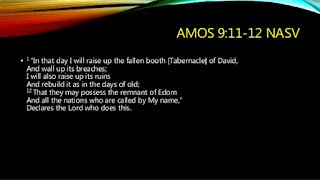THE LIVES OF THE PATRIARCHS #156 | THE LIFE OF MOSES #137
Pastor Christopher Choo
Lesson 3842
THE LIVES OF THE PATRIARCHS #156
THE LIFE OF MOSES #137
MOSES AT MT. SINAI #36
THE TRANSFORMING GLORY OF GOD #20
THE ARK OF THE COVENANT ( Part 12 )
THE ARK IN THE TABERNACLE OF DAVID.
When David brought the Ark from the house of Obed Edom to Jerusalem, the Ark was housed in a makeshift tent called the Tabernacle of David until the Temple of Solomon was completed.
1. There was no veil separating the ark and worshippers.
2. David instituted 24 hour praise and worship sessions before the ark with various worship teams taking part one after another.
The bible tells us he appointed 288 prophetic singers and 4,000 musicians to minister before the Lord, “to make petition, to give thanks and to praise the Lord” day and night (1 Chronicles 15:1–17:27).
The outcome of such worship enlarged the borders of Israel which grew to its greatest extent under David's kingdom as worship in his tabernacle brought down God's presence among His people.
Please note that during the time of the reign of Kind David and this day and night worship at the Tabernacle of David, there were no wars in Jerusalem for 33 years. It was a time of peace for the city!
Let us study the prophetic significance of David's Tabernacle.
During David’s time the tabernacle (or tent) housed the Ark of the Covenant and was a precursor to the Temple that Solomon would build.
The Temple was no longer a makeshift tent but a rectangular building of worship made with elaborate design. Its presence and functionality, with priests, was a sign of God’s favor and presence. When Israel fell away from following the commandments of the Old Covenant, the temple was desecrated and needed to eventually be rebuilt, as described in the book of Ezra.
But the prophetic lessons of the humble Tabernacle of David should not be lost.
The Hebrew word translated “tabernacle” is ohel, which means “a tent (as clearly conspicuous from a distance): a covering, (dwelling) (place), home, tabernacle, tent.”
There are three main references to the tabernacle (or tent) of David: Isaiah 16:5, Amos 9:11, and Acts 15:16, in which the apostle James repeats the passage from Amos.
The reference in Isaiah 16:5 refers to the tabernacle of David prophetically, pointing to One from the line of David who will someday sit on the throne and rule over all. This is referring to Jesus.
That leaves two other references to the tabernacle of David.
In Acts 15:16, while speaking to the Jews, James uses Amos 9:11 to give credence to the recent conversion of the Gentiles in the early church. Many Jews were objecting to this because there was uncertainty as to how the Gentiles were to now keep the Law of Moses. The essential argument from Peter’s earlier experience with Cornelius, a Gentile, was that God was also calling Gentiles to Himself. The apostles were not to put on the Gentiles a burden that no one could ever keep (i.e. the Law of Moses).
From James’ words alone, it is clear that God’s promise through the prophet Amos—that He would “build again the tabernacle of David”—was related to what He was just then beginning to do, namely, visiting the Gentiles to take out from among them a people for His Name. After rehearsing what Simon Peter had just told the Jerusalem Christians—that God had chosen Peter as the instrument whereby He, for the first time, opened the way of salvation to the Gentiles—James plainly declared that God’s visitation of the Gentiles agreed with the words of the prophets (in general) and Amos (in particular).
The “tabernacle” referred to in Acts 15:16, then, is the house of God open to all, both Jew and Gentile, who seek Him in order to worship in truth.
Amos 9:11 says, “In that day will I raise up again the tabernacle of David, that is fallen.” There seems to be reference here to a restoration of the Jewish nation to spiritual life in the end time. There might also exist, during that end time, or into the 1,000-year reign of Christ, a tabernacle like the one during David’s day.
Conclusion
The Tabernacle of David was a prophetic picture of our worship before God's throne without the veil separating us from His glory ( depicted by the ark in David's time ).
Because of Jesus' death on the Cross, the veil of separation no longer exists between God and Man.
And we can boldly enter into His presence as such to seek His grace and mercy in time of need ( Hebrews 4:16 )
"Let us therefore come boldly to the throne of grace, that we may obtain mercy and find grace to help in time of need."
Thus will the Lord's prayer be answered that " Thy kingdom come,Thy will be done on earth as it is in heaven." ( Matthew6:9-15 )
God’s kingdom has not yet been wholly fulfilled on this earth. Thy kingdom come is not just an expectant yearning for the coming of Christ in the future, even though this longing is contained in the plea. But Thy kingdom come also expresses the prayerful desire of Christ’s servants to see God’s Kingdom broaden and become increasingly established throughout the world in the here and now.
Thus our worship in spirit and in truth as a lifestyle and calling is a key to establishing God's kingdom on earth.
As in the days of David in his makeshift tabernacle! Then as now in God's prophetic calendar.







